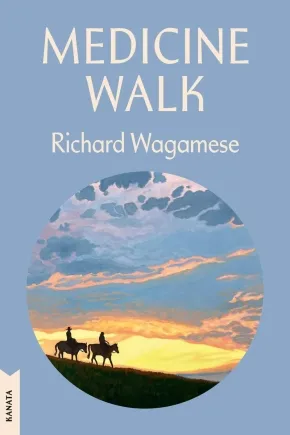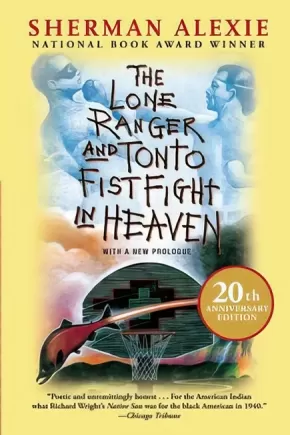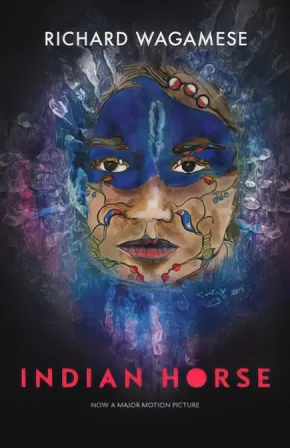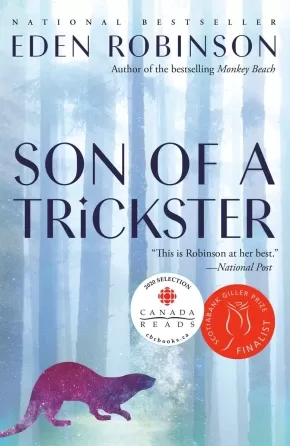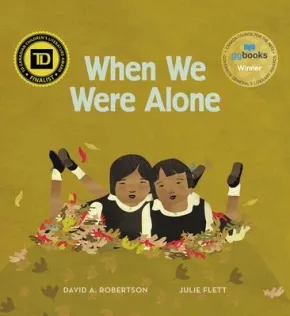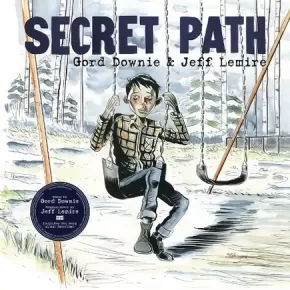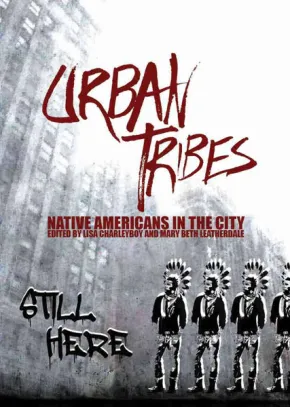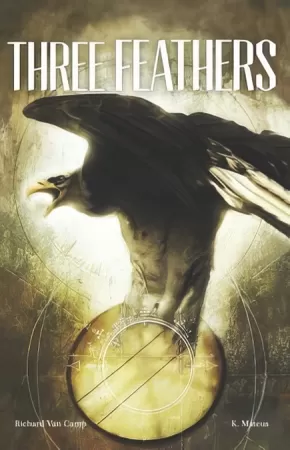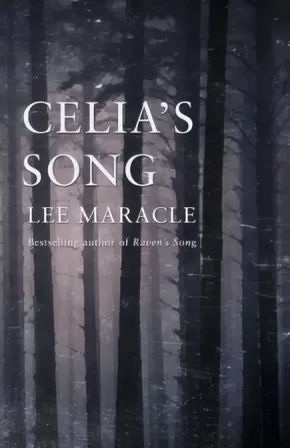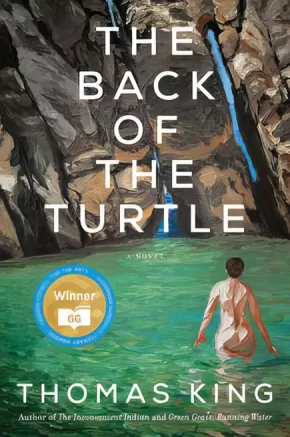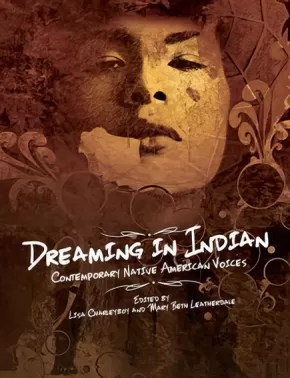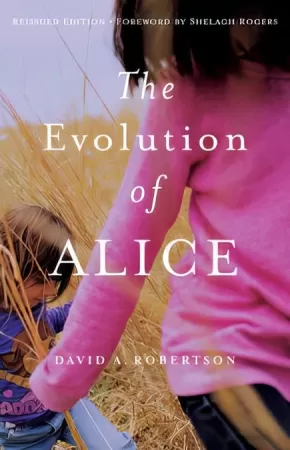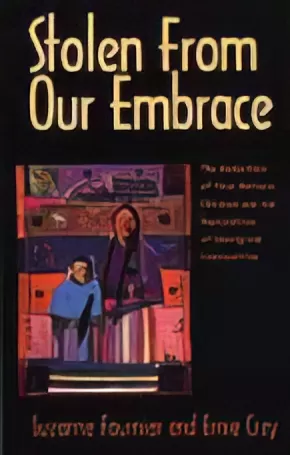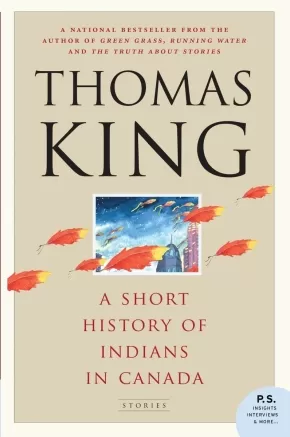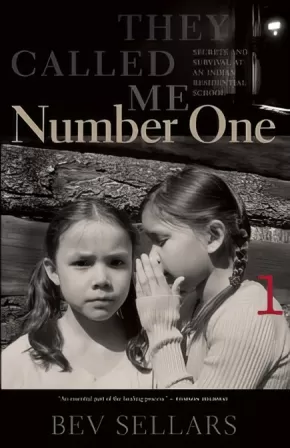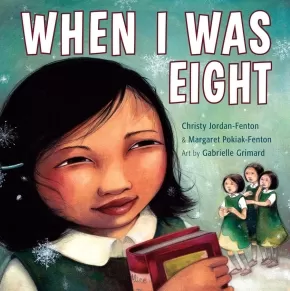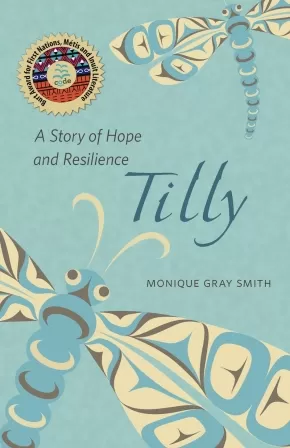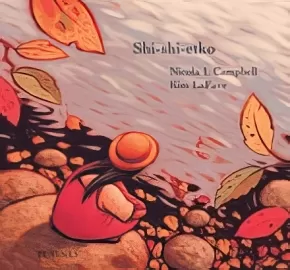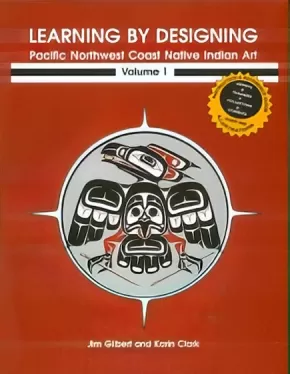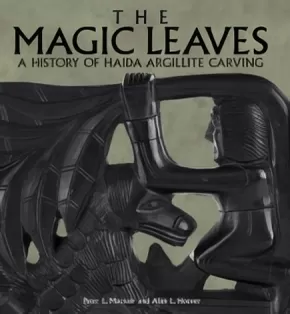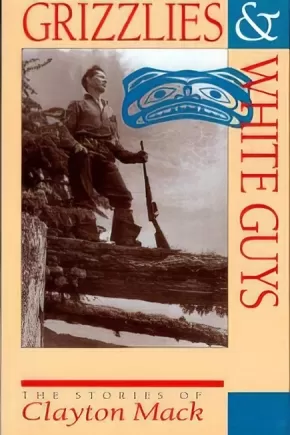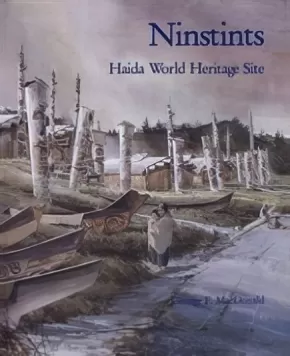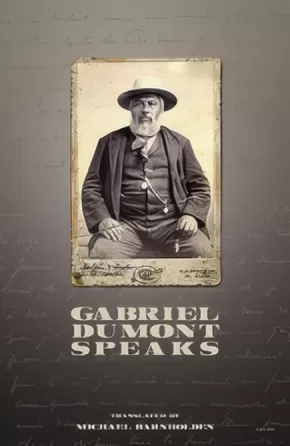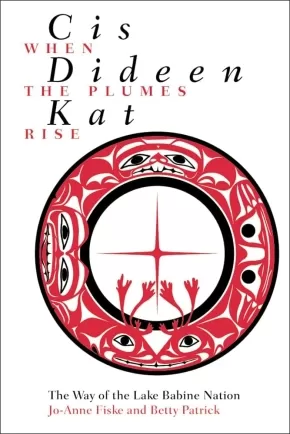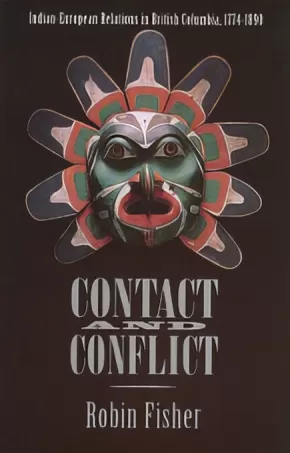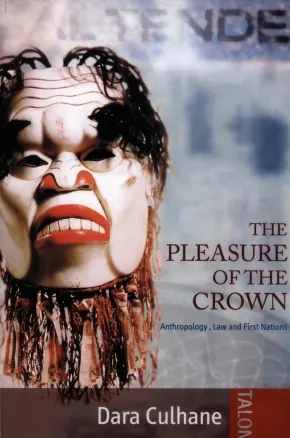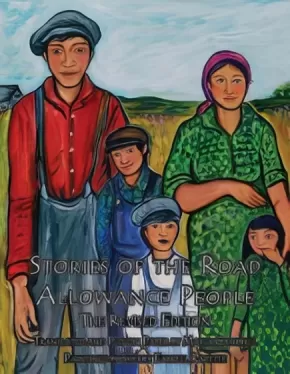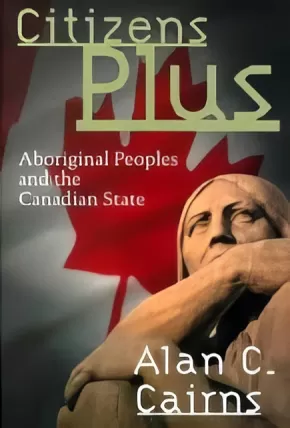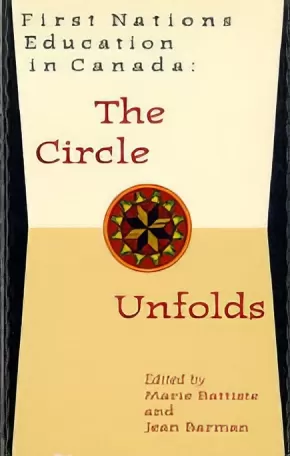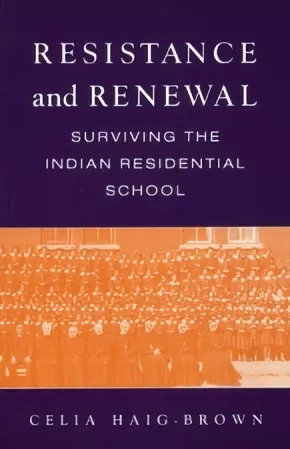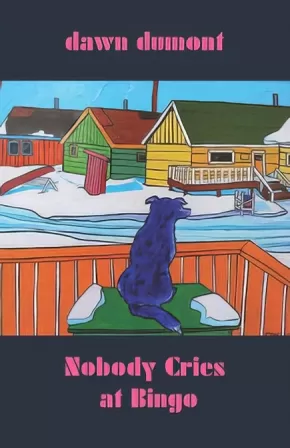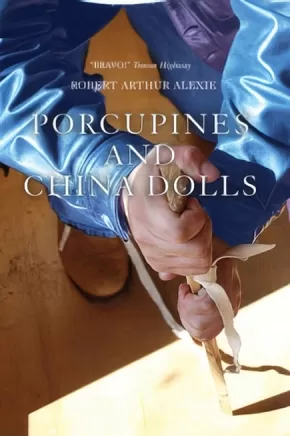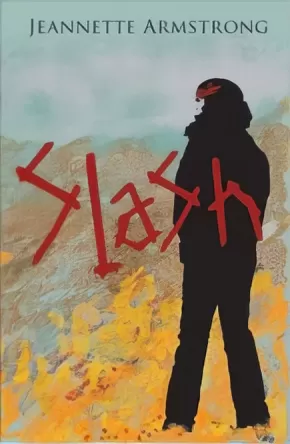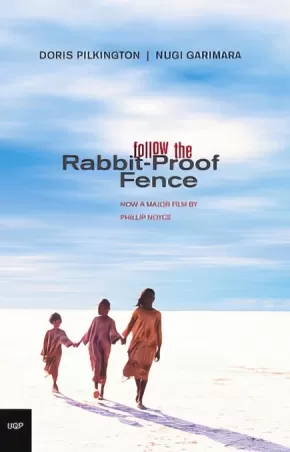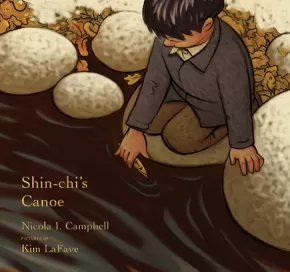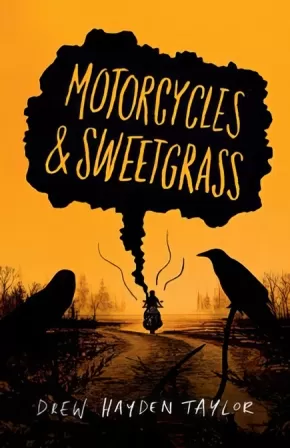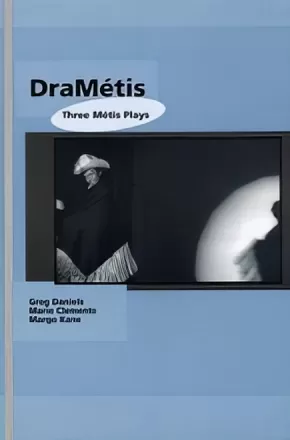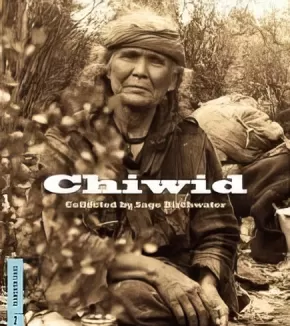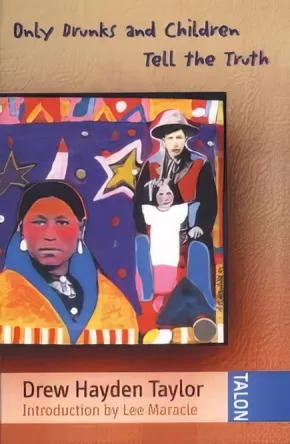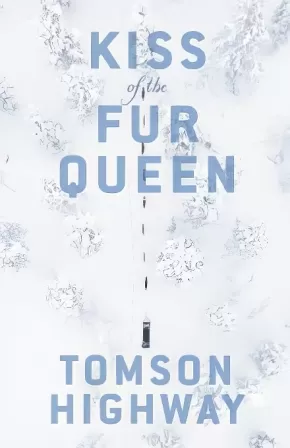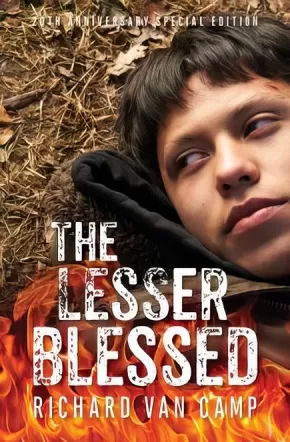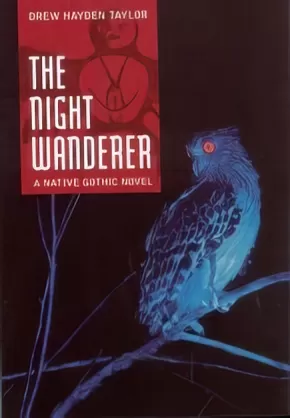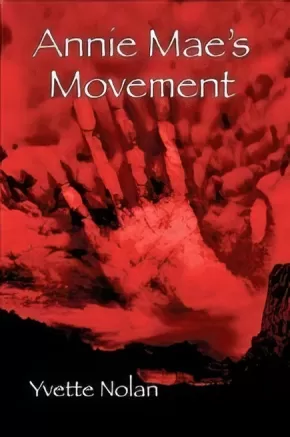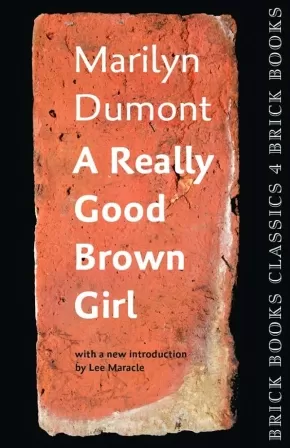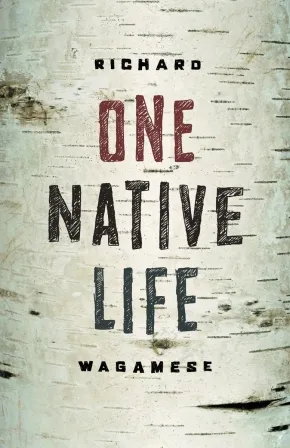
Canadian Indigenous Courses
1
-
15
of
57 Results;
Sort By
Go To
of 4
Medicine Walk: Kanata Classics Edition
$22.00
Format:
Paperback
Text Content Territories:
Indigenous Canadian; First Nations; Anishinaabeg; Ojibway;
ISBN / Barcode: 9780771023521
Synopsis:
Synopsis:
By the celebrated author of Canada Reads Finalist Indian Horse, a stunning new novel that has all the timeless qualities of a classic, as it tells the universal story of a father/son struggle in a fresh, utterly memorable way, set in dramatic landscape of the BC Interior. For male and female readers equally, for readers of Cormac McCarthy, Thomas King, Russell Banks, and general literary.
Franklin Starlight is called to visit his father, Eldon. He's sixteen years old and has had the most fleeting of relationships with the man. The rare moments they've shared haunt and trouble Frank, but he answers the call, a son's duty to a father. He finds Eldon decimated after years of drinking, dying of liver failure in a small town flophouse. Eldon asks his son to take him into the mountains, so he may be buried in the traditional Ojibway manner.
What ensues is a journey through the rugged and beautiful backcountry, and a journey into the past, as the two men push forward to Eldon's end. From a poverty-stricken childhood, to the Korean War, and later the derelict houses of mill towns, Eldon relates both the desolate moments of his life and a time of redemption and love and in doing so offers Frank a history he has never known, the father he has never had, and a connection to himself he never expected.
A novel about love, friendship, courage, and the idea that the land has within it powers of healing, Medicine Walk reveals the ultimate goodness of its characters and offers a deeply moving and redemptive conclusion.
Wagamese's writing soars and his insight and compassion are matched by his gift of communicating these to the reader.
Reviews
“In Medicine Walk, Wagamese manages the nuances of betrayal and redemption with uncommon artistry. It is a breathtaking novel of sorrow, hope and polished steel.” – Thomas King
“A deeply felt and profoundly moving novel, written in the kind of sure, clear prose that brings to mind the work of the great North American masters; Steinbeck among them. But Wagamese's voice and vision are also completely his own, as is the important and powerful story he has to tell.” – Jane Urquhart
“Medicine Walk recounts the mythic journey of an estranged father and son who are searching for reconciliation and love. Richard Wagamese’s novel renders the Canadian wilderness with staggering insight and beauty. The same can be said for his understanding of the fragility, wildness and resilience of the human heart. Magnificent.” – Lisa Moore
“Medicine Walk is a masterpiece, a work of art that explores human interconnectedness with a level of artistry so superb that the personal becomes eternal.” – National Post
“A moving story…. Wagamese balances the novel’s spiritual and political subtexts with sly humour, sharp, believable dialogue and superb storytelling skills. Medicine Walk is a major accomplishment from an author who has become one of Canada’s best novelists.” – Toronto Star
“This is very much a novel about the role of stories in our lives, those we tell ourselves about ourselves and those we agree to live by…. Wagamese understands that the stories we don’t tell are as important as the ones we do….But Medicine Walk is also testament to the redemptive power of love and compassion.” – Globe and Mail
“One of the finest novels of the year…. Medicine Walk is not only a graceful book, it is a novel of grace, of coming to terms with hidden truths, of coming to know the secrets behind forbidding appearances, of finding the humanity within strangers.” – Vancouver Sun
“An essential read…. Superbly written.” – Now Magazine (NNNN)
Educator & Series Information
This edition of Medicine Walk is part of the Kanata Classics series, which celebrates timeless books that reflect the rich and diverse range of voices in Canadian literature.
Grades 10-12 BC English First Peoples resource for units on Childhood, Place-Conscious Learning, and Family.
Additional Information
256 pages | 5.50" x 8.25" | Paperback
The Lone Ranger and Tonto Fistfight in Heaven - 20th Anniversary Edition
$24.50
Format:
Paperback
Text Content Territories:
Indigenous American; Native American; Salish; Interior Salish; Spokane;
ISBN / Barcode: 9780802121998
Synopsis:
Synopsis:
Sherman Alexie’s celebrated first collection, The Lone Ranger and Tonto Fistfight in Heaven, established its author as one of America’s most important and provocative voices. The basis for the award-winning movie Smoke Signals, it remains one of his best loved and widely praised books twenty years after its initial publication.
Vividly weaving memory, fantasy, and stark reality to paint a portrait of life in and around the Spokane Indian reservation, this book introduces some of Alexie’s most beloved characters, including Thomas Builds-the-Fire, the storyteller who no one seems to listen to, and his compatriot, Victor, the sports hero who turned into a recovering alcoholic. Now with an updated introduction from Alexie, these twenty-four tales are narrated by characters raised on humiliation and government-issue cheese, and yet they are filled with passion and affection, myth and charm. Against a backdrop of addiction, car accidents, laughter, and basketball, Alexie depicts the distances between men and women, Indians and whites, reservation Indians and urban Indians, and, most poetically, modern Indians and the traditions of the past.
Educator Information
Resource for English First Peoples 10-12.
Short stories.
Additional Information
304 pages | 5.50" x 8.25"
Indian Horse (Special Edition)
$21.95
Format:
Paperback
Text Content Territories:
Indigenous Canadian; First Nations; Anishinaabeg; Ojibway;
ISBN / Barcode: 9781771621908
Synopsis:
Synopsis:
Saul Indian Horse has hit bottom. His last binge almost killed him, and now he’s a reluctant resident in a treatment centre for alcoholics, surrounded by people he’s sure will never understand him. But Saul wants peace, and he grudgingly comes to see that he’ll find it only through telling his story. With him, readers embark on a journey back through the life he’s led as a northern Ojibway, with all its joys and sorrows.
With compassion and insight, author Richard Wagamese traces through his fictional characters the decline of a culture and a cultural way. For Saul, taken forcibly from the land and his family when he’s sent to residential school, salvation comes for a while through his incredible gifts as a hockey player. But in the harsh realities of 1960s Canada, he battles obdurate racism and the spirit-destroying effects of cultural alienation and displacement. Indian Horse unfolds against the bleak loveliness of northern Ontario, all rock, marsh, bog and cedar. Wagamese writes with a spare beauty, penetrating the heart of a remarkable Ojibway man.
Awards
- 2013 Burt Award for First Nations, Métis, and Inuit Literature
- 2013 First Nation Communities Read Award
Reviews
"Richard Wagamese is a master storyteller, who blends the throb of life with spiritual links to the land, hard work, and culture to find success, his words take you into the soul of Indian Horse, to experience his pain, his growing resentments, his depression, and his fear which has to be faced if he is to regain the joy of life. This book is meant for youth, adults, and elders, to be shared, to be lived, and to be treasured for the clear message of hope and the need to go the distance." — Wawatay News
“…The hockey chapters are compelling; they evoke Sherman Alexie’s fiction that examines contemporary life on American Indian reservations through the lens of basketball. But it is as a story of reconciliation that this novel reveals Wagamese’s masterful subtly…In a single image, Wagamese complicates in blinding ways the entire narrative; in a single page, Indian Horse deepens from an enjoyable read to a gripping critique of Canada.” — Kyle Carsten Wyatt, The Walrus, 2012
Educator Information
Grades 10-12 BC English First Peoples resource for units on Lost People, Reconciliation, and Place-Conscious Learning.
Caution: Substance Abuse, Mature Content
Additional Information
232 pages | 5.50" x 8.50"
This special edition of Richard Wagamese’s novel Indian Horse has been released to coincide with the release of the film Indian Horse in the spring of 2018.
The Marrow Thieves
$19.95
Format:
Paperback
Text Content Territories:
Indigenous Canadian; Métis;
ISBN / Barcode: 9781770864863
Synopsis:
Synopsis:
Humanity has nearly destroyed its world through global warming, but now an even greater evil lurks. The indigenous people of North America are being hunted and harvested for their bone marrow, which carries the key to recovering something the rest of the population has lost: the ability to dream. In this dark world, Frenchie and his companions struggle to survive as they make their way up north to the old lands. For now, survival means staying hidden - but what they don't know is that one of them holds the secret to defeating the marrow thieves.
Awards
- Winner of 2017 Governor General's Literary Award
- Winner of 2017 Kirkus Prize
- Winner of the 2018 Burt Literary Award for First Nations, Inuit, and Métis Young Adult Literature.
Reviews
“Miigwans is a true hero; in him Dimaline creates a character of tremendous emotional depth and tenderness, connecting readers with the complexity and compassion of Indigenous people. A dystopian world that is all too real and that has much to say about our own.”— Kirkus Reviews
"There's a quality in Dimaline's writing that reached from the page, into my being ... That's a specific reference to the residential schools of the past, where so much was taken from Native children. It is one of many points in The Marrow Thieves where - painfully or with exquisite beauty - Dimaline's story resonates with me. It will resonate with other Native readers, too, especially those who are Anishinabe. Several tribal nations are mentioned in here, too ... There's so much more to say ... about Miggs and Isaac, about Ri, about Minerva, about French. But I'll stop and let you be with these achingly dear characters. I highly recommend The Marrow Thieves." — Debbie Reese, American Indians in Children's Literature
"In The Marrow Thieves, Cherie Dimaline creates a near-future world which distinctly echoes our own, current and past traumas that have come back to repeat themselves, fiction with a basis in reality that gives the narrative a sheen of hard truths, following the trials and tribulations of a relatable cast of characters and their struggles to survive, and live their lives with the love and safety denied to them. The high-stakes tension of each scene pulls the reader along through the story, with a core message about our dreams and culture, which despite losses, has the potential to heal, and the power to restore." — Trillium Book Award Jury Citation, June 2018
"[The Marrow Thieves] brilliantly connects the legacy of residential schools to a dystopian post-climate-change future where only Indigenous people are able to dream. Dimaline’s novel reminds us of the power of storytelling and the importance of community, reinforced for the disenfranchised children by the wisdom of the heroic elder, Miigwans. The writing is painful yet beautiful, bleak but ultimately hopeful. In this era of reconciliation, Cherie Dimaline’s The Marrow Thieves is a work of speculative fiction that resonates and stays with the reader long past the last page." — Sunburst Award Jury Citation, October 2018
Educator & Series Information
Recommended Ages: 13+
Recommended English First Peoples resource for grades 11-12.
This book is part of the Marrow Thieves series.
The Canadian Indigenous Books for Schools list recommends this resource for Grades 9-12 English Language Arts.
Caution: This book touches on physical and sexual violence.
DCB Young Readers has created a Teacher's Guide for this resource, which can be downloaded here: Teachers Guide - The Marrow Thieves
This resource is also available in French: Pilleurs de rêves
Additional Information
180 pages | 5.00" x 8.00"
Son of a Trickster (PB)
$23.00
Format:
Paperback
Text Content Territories:
Indigenous Canadian; First Nations; Haisla (Kitamaat);
ISBN / Barcode: 9780345810793
Synopsis:
Synopsis:
Shortlisted for the Scotiabank Giller Prize: With striking originality and precision, Eden Robinson, the author of the classic Monkey Beach and winner of the Writers’ Trust of Canada Fellowship, blends humour with heartbreak in this compelling coming-of-age novel. Everyday teen existence meets indigenous beliefs, crazy family dynamics, and cannibalistic river otters...The exciting first novel in her trickster trilogy.
Everyone knows a guy like Jared: the burnout kid in high school who sells weed cookies and has a scary mom who's often wasted and wielding some kind of weapon. Jared does smoke and drink too much, and he does make the best cookies in town, and his mom is a mess, but he's also a kid who has an immense capacity for compassion and an impulse to watch over people more than twice his age, and he can't rely on anyone for consistent love and support, except for his flatulent pit bull, Baby Killer (he calls her Baby)--and now she's dead.
Jared can't count on his mom to stay sober and stick around to take care of him. He can't rely on his dad to pay the bills and support his new wife and step-daughter. Jared is only sixteen but feels like he is the one who must stabilize his family's life, even look out for his elderly neighbours. But he struggles to keep everything afloat...and sometimes he blacks out. And he puzzles over why his maternal grandmother has never liked him, why she says he's the son of a trickster, that he isn't human. Mind you, ravens speak to him--even when he's not stoned.
You think you know Jared, but you don't.
Reviews
“Eden Robinson’s Son of a Trickster is a novel that shimmers with magic and vitality, featuring a compelling narrator, somewhere between Holden Caulfield and Harry Potter. Just when you think Jared’s teenage journey couldn’t be more grounded in gritty, grinding reality, his addled perceptions take us into a realm beyond his small-town life, somewhere both seductive and dangerous. Energetic, often darkly funny, sometimes poignant, this is a book that will resonate long after the reader has devoured the final page.” —2017 Scotiabank Giller Prize jury (André Alexis, Anita Rau Badami, Lynn Coady, and Richard Beard)
Educator & Series Information
This is the first book in Eden Robinson's Trickster Trilogy. It is followed by Trickster Drift.
Grades 11-12 BC English First Peoples resource for the unit What Creates Family.
Note: This novel contains mature subject matter, such as drug use and depictions of sex and violence.
This book is available in French: Le fils du Trickster
Additional Information
336 pages | 5.20" x 8.00" | Paperback
When We Were Alone
$21.95
Artists:
Format:
Hardcover
Text Content Territories:
Indigenous Canadian; First Nations; Cree (Nehiyawak);
ISBN / Barcode: 9781553796732
Synopsis:
Synopsis:
When a young girl helps tend to her grandmother’s garden, she begins to notice things that make her curious. Why does her grandmother have long, braided hair and beautifully coloured clothing? Why does she speak another language and spend so much time with her family? As she asks her grandmother about these things, she is told about life in a residential school a long time ago, where all of these things were taken away. When We Were Alone is a story about a difficult time in history, and, ultimately, one of empowerment and strength.
Reviews
"When We Were Alone is rare. It is exquisite and stunning, for the power conveyed by the words Robertson wrote, and for the illustrations that Flett created. I highly recommend it." — Debbie Reese, American Indians in Children's Literature.
"…Robertson handles a delicate task here admirably well: explaining residential schools, that shameful legacy, and making them understandable to small children. It’s a dark history, and the author doesn’t disguise that, but he wisely focuses the grandmother’s tale on how, season by season, the students use creativity, imagination, and patience to retain their sense of identity. A beautifully quiet, bold strength arises from the continued refrain “When we were alone” and in how the children insisted on being themselves. Flett’s gorgeous, skillful illustrations have a flattened, faux naïve feel to them, like construction paper collage, a style that works perfectly with the story. She nicely contrasts the school’s dull browns and grays with the riotous colors surrounding Nókom and gets much expression from her simple silhouettes. Spare, poetic, and moving, this Cree heritage story makes a powerful impression." — Kirkus Reviews
"When We Were Alone addresses the topic of residential schools and, just as importantly, aspects of Cree culture and language. There is such gentleness about When We Were Alone that makes it an appropriate book for the even youngest of readers. Simply put, this is a much-needed book. Highly Recommended." — Dr. Kristen Ferguson, CM Magazine
"Robertson's text moves between the present and the past, the girl's questions and Nókom's memories, which deepen and intensify the quiet, powerful way she lives out her own culture, day by day, in the present. A beautifully rendered story of resisitance and love, this is made all the more luminous by Flett's art - not just by flashes of fuschsia or scarlet among ochre grasses, but by her precisely observed images of the compact bodies of the uniformed children, bowed beneath the weight of the scissors, or lovingly tending each other's hair. Highly recommended." — Deirdre Baker, Toronto Star
"When We Were Alone is a story about finding the strength to push forward when everything is against you. It follows a young girl asking her grandmother questions to learn more about her past. The grandmother shares her experience of a time when she was unable to make her own decisions and how she got through it." — The Dalai Lama Center
Educator Information
Recommended Grades: 3 and under.
Grades 10-11 BC English First Peoples resource for the unit First Steps - Exploring Residential School and Reconciliation through Children's Literature.
This book is also available in Swampy Cree syllabics and Roman orthography, as well as the original English: Ispík kákí péyakoyak/When We Were Alone
This resource is also available in French: Quand on etait seuls
Additional Information
24 pages | 8.50" x 7.50" | colour illustrations
Secret Path
$26.99
Format:
Paperback
Text Content Territories:
Indigenous Canadian;
ISBN / Barcode: 9781501155949
Synopsis:
Synopsis:
Secret Path is a ten song album by Gord Downie with a graphic novel by illustrator Jeff Lemire that tells the story of Chanie “Charlie” Wenjack, a twelve-year-old boy who died in flight from the Cecilia Jeffrey Indian Residential School fifty years ago.
Chanie, misnamed Charlie by his teachers, was a young boy who died on October 22, 1966, walking the railroad tracks, trying to escape from the Cecilia Jeffrey Indian Residential School to return home. Chanie’s home was 400 miles away. He didn’t know that. He didn’t know where it was, nor how to find it, but, like so many kids—more than anyone will be able to imagine—he tried.
Chanie’s story is Canada’s story. We are not the country we thought we were. History will be re-written. We are all accountable. Secret Path acknowledges a dark part of Canada’s history—the long-suppressed mistreatment of Indigenous children and families by the residential school system—with the hope of starting our country on a road to reconciliation. Every year as we remember Chanie Wenjack, the hope for Secret Path is that it educates all Canadians young and old on this omitted part of our history, urging our entire nation to play an active role in the preservation of Indigenous lives and culture in Canada.
The next hundred years are going to be painful as we come to know Chanie Wenjack and thousands like him—as we find out about ourselves, about all of us—but only when we do can we truly call ourselves, “Canada.”
Proceeds from Secret Path will be donated to The Gord Downie Secret Path Fund for Truth and Reconciliation via The National Centre for Truth and Reconciliation (NCTR) at The University of Manitoba.
Educator Information
Recommended resource for English First Peoples grades 10-11 for units on Childhood through the Eyes of Indigenous Writers and First Steps - Exploring Residential School and Reconciliation through Children's Literature.
Note: This resource is not considered an authentic First Peoples resource.
Additional Information
96 pages | 12.00" x 12.00"
The Break
$23.99
Format:
Paperback
Text Content Territories:
Indigenous Canadian; Métis;
ISBN / Barcode: 9781487001117
Synopsis:
Synopsis:
When Stella, a young Métis mother, looks out her window one evening and spots someone in trouble on the Break — a barren field on an isolated strip of land outside her house — she calls the police to alert them to a possible crime.
In a series of shifting narratives, people who are connected, both directly and indirectly, with the victim — police, family, and friends — tell their personal stories leading up to that fateful night. Lou, a social worker, grapples with the departure of her live-in boyfriend. Cheryl, an artist, mourns the premature death of her sister Rain. Paulina, a single mother, struggles to trust her new partner. Phoenix, a homeless teenager, is released from a youth detention centre. Officer Scott, a Métis policeman, feels caught between two worlds as he patrols the city. Through their various perspectives a larger, more comprehensive story about lives of the residents in Winnipeg’s North End is exposed.
A powerful intergenerational family saga, The Break showcases Vermette’s abundant writing talent and positions her as an exciting new voice in Canadian literature.
Awards
- 2017 Burt Award for First Nations, Inuit, and Métis Literature Winner
- Margaret Laurence Award for Fiction Winner
- McNally Robison Book of the Year Winner
- Amazon.ca First Novel Award
Reviews
“Vermette is a staggering talent. Reading The Break is like a revelation; stunning, heartbreaking and glorious. From her exquisitely rendered characters to her fully realized world and the ratcheting tension, I couldn’t put it down. Absolutely riveting.” — Eden Robinson, author of Monkey Beach
“In Vermette’s poetic prose, The Break offers a stark portrayal of the adversity that plagues First Nations women in this country — and the strength that helps them survive.” — Toronto Star
“The Break doesn’t read like an impressive first novel; it reads like a masterstroke from someone who knows what they’re doing . . . Vermette is skilled at writing with a language that is conversational and comfortable and with a poetic ease that makes the hard things easier to swallow. The result is a book that is at times emotionally demanding, funny, suspenseful, and always engaging.”—The Winnipeg Review
“This is a debut novel by the Governor General's Literary Award-winning Métis poet Katherena Vermette. The story takes place in Winnipeg's North End. And it starts when Stella thinks she sees a violent assault taking place in a barren strip of land outside her window, known as The Break. Turns out, she is right. In fact, there is a threat of violence that hovers over all the women in the story, three generations of them, and the story is told in many voices. Katherena writes with empathy and understanding about people who are living with the pain of intergenerational trauma. The Winnipeg winter she evokes is cold and cruel. But there is such love, loyalty and support in this story. If you enjoy a gripping family saga, I would recommend The Break.” — Shelagh Rogers, CBC The Next Chapter
Educator Information
Grades 11-12 BC English First Peoples resource for the unit What Creates Family?
The Canadian Indigenous Books for School list recommends this resource for Grades 10-12 English Language Arts.
Curriculum Connections: English, Indigenous Studies, Anthropology
Note: This novel contains mature and challenging content, such as incidents of drug use, rape, and, violence.
Additional Information
288 pages | 5.25" x 8.00"
Urban Tribes: Native Americans in the City
$14.95
Editors:
Format:
Paperback
Text Content Territories:
Indigenous Canadian; Indigenous American;
ISBN / Barcode: 9781554517503
Synopsis:
Synopsis:
The majority of Natives in North America live "off the rez." How do they stay rooted to their culture? How do they connect with their community?
Urban Tribes offers unique insight into this growing and often misperceived group. This anthology profiles young urban Natives and how they connect with Native culture and values in their contemporary lives.
Their stories are as diverse as they are. From a young Dene woman pursuing an MBA at Stanford University to a Pima photographer in Phoenix to a Mohawk actress in New York City, these urban Natives share their unique insight to bridge the divide between their past and their future, their cultural home, and their adopted cities.
Unflinchingly honest and deeply moving, the contributors explore a wide range of topics: from the trials and tribulations of dating in the city to the alienating experience of leaving a remote reserve to attend high school in the city, from the mainstream success of the Electric Pow Wow music genre to the humiliation of racist school mascots.
Each of the personal perspectives helps to illuminate larger political issues. An innovative and highly visual design offers a dynamic reading experience.
Educator Information
Recommended Ages: 11 - 18.
Recommended Authentic First Peoples resource.
Recommended English First Peoples resource.
Additional Information
136 pages | 6.75" x 9.50" | colour illustrations and photographs, foreward, introduction, bibliography
Three Feathers
$18.95
Artists:
Format:
Paperback
Text Content Territories:
Indigenous Canadian;
ISBN / Barcode: 9781553795360
Synopsis:
Synopsis:
Three young men—Flinch, Bryce, and Rupert—have vandalized their community and are sent by its Elders to live nine months on the land as part of the circle sentencing process. There, the young men learn to take responsibility for their actions and acquire the humility required to return home. But, when they do return, will they be forgiven for what they’ve done?
Three Feathers explores the power and grace of restorative justice in one Northern community and the cultural legacy that can empower future generations.
Three Feathers is the third title in The Debwe Series. Created in the spirit of the Anishinaabe concept debwe (to speak the truth), The Debwe Series is a collection of exceptional Aboriginal writings from across Canada.
Reviews
"Three Feathers is a graphic novel illustrated by stark, black and white images. Many of the frames have no captioning, inviting the reader to intuit the narrative. K. Mateus, the illustrator, makes imaginative use of Aboriginal symbols and motifs in this 48 page book; when Gabe is attacked, demonic figures shadow the background, and when Bryce rails at the members of the community sentencing circle, the image of an angry wildcat snarls behind him." - CM Magazine
Educator & Series Information
Grades 10-12 BC English First Peoples Resource for units on Childhood and Place-Conscious Learning.
Recommended for grades 9 to 12.
This book is part of The Debwe Series, which features exceptional Indigenous writings from across Canada.
This book is available in French: Trois Plumes
Additional Information
48 pages | 6.50" x 10.00"
Celia's Song
$22.95
Format:
Paperback
Text Content Territories:
Indigenous Canadian; First Nations; Nuu-chah-nulth (Nootka);
ISBN / Barcode: 9781770864511
Synopsis:
Synopsis:
Mink is a witness, a shape shifter, compelled to follow the story that has ensnared Celia and her village, on the West coast of Vancouver Island in Nu:Chahlnuth territory. Celia is a seer who - despite being convinced she's a little "off" - must heal her village with the assistance of her sister, her mother and father, and her nephews. While mink is visiting, a double-headed sea serpent falls off the house front during a fierce storm. The old snake, ostracized from the village decades earlier, has left his terrible influence on Amos, a residential school survivor. The occurrence signals the unfolding of an ordeal that pulls Celia out of her reveries and into the tragedy of her cousin's granddaughter. Each one of Celia's family becomes involved in creating a greater solution than merely attending to her cousin's granddaughter. Celia's Song relates one Nu:Chahlnuth family's harrowing experiences over several generations, after the brutality, interference, and neglect resulting from contact with Europeans.
Educator Information
Grade 11/12 English First Peoples resource for the unit Further Steps toward Reconciliation.
Additional Information
280 pages | 5.50" x 8.50"
The Back Of The Turtle
$22.99
Format:
Paperback
Text Content Territories:
Indigenous Canadian;
ISBN / Barcode: 9781443431637
Synopsis:
Synopsis:
This is Thomas King’s first literary novel in fifteen years and follows on the success of the award-winning and bestselling The Inconvenient Indian and his beloved Green Grass, Running Water and Truth and Bright Water, both of which continue to be taught in Canadian schools and universities. Green Grass, Running Water is widely considered a contemporary Canadian classic.
In The Back of the Turtle, Gabriel returns to Smoke River, the reserve where his mother grew up and to which she returned with Gabriel’s sister. The reserve is deserted after an environmental disaster killed the population, including Gabriel’s family and the local wildlife. Gabriel, a brilliant scientist working for Domidion, created GreenSweep and indirectly led to the crisis. Now he has come to see the damage and to kill himself in the sea. But as he prepares to let the water take him, he sees a young girl in the waves. Plunging in, he saves her and soon is saving others. Who are these people with their long black hair and almond eyes who have fallen from the sky?
Filled with brilliant characters, trademark wit, wordplay and a thorough knowledge of native myth and storytelling, this novel is a masterpiece by one of our most important writers.
Reviews
“Gracefully written, this is a fable-like morality tale. With King’s trademark flashes of humour, irony and deadpan delivery, The Back of the Turtle is populated with wounded characters who are trying to heal in the wake of an environmental disaster.” — Toronto Star
“King’s writing is sharp, the characters are well-drawn, and his topic is suitably grave.” — National Post
"King deftly juxtaposes the varieties of Canadian experience, contrasting the shining city with diminishing coastal town, the lives of the uber-wealthy with those of aboriginal Canadians, whose lives seem to count for very little when there is a profit to be made. King uses his trademark blending of traditional aboriginal beliefs and stories with the Western literary canon to create a haunting narrative of life, death and the destruction of nature. Allusions abound, incorporated into the story with King's often absurdist wit, walking a fine line between humor and heartbreak. The result is both an intimate story of grief in the face of loved ones lost and a searing criticism of current apathy toward looming environmental disasters." - Publisher's Weekly
Educator Information
Grades 11-12 English First Peoples resource for the unit "You Want Me to Write a What?" - The Literary Essay.
Additional Information
528 pages | 5.31" x 8.00"
Dreaming in Indian: Contemporary Native American Voices
$19.95
Artists:
Editors:
Format:
Hardcover
Text Content Territories:
Indigenous American; Indigenous Canadian;
ISBN / Barcode: 9781554516872
Synopsis:
Synopsis:
A powerful and visually stunning anthology from some of the most groundbreaking Native artists working in North America today.
Truly universal in its themes, Dreaming In Indian will shatter commonly held stereotypes and challenge readers to rethink their own place in the world. Divided into four sections, ‘Roots,’ ‘Battles,’ ‘Medicines,’ and ‘Dreamcatchers,’ this book offers readers a unique insight into a community often misunderstood and misrepresented by the mainstream media.
Emerging and established Native artists, including acclaimed author Joseph Boyden, renowned visual artist Bunky Echo Hawk, and stand-up comedian Ryan McMahon, contribute thoughtful and heartfelt pieces on their experiences growing up Indigenous, expressing them through such mediums as art, food, the written word, sport, dance, and fashion. Renowned chef Aaron Bear Robe, for example, explains how he introduces restaurant customers to his culture by reinventing traditional dishes. And in a dramatic photo spread, model Ashley Callingbull and photographer Thosh Collins reappropriate the trend of wearing ‘Native’ clothing.
Whether addressing the effects of residential schools, calling out bullies through personal manifestos, or simply citing hopes for the future, Dreaming In Indian refuses to shy away from difficult topics. Insightful, thought-provoking, and beautifully honest, this book will to appeal to young adult readers. An innovative and captivating design enhances each contribution and makes for a truly unique reading experience.
Reviews
“It’s hard to imagine a middle- or high-school classroom that wouldn’t benefit from having this.” —Booklist, 02/15
“Belongs in every middle school, high school and public library.” —CM Reviews, 05/22/15
"For some time now, I've been waiting for Dreaming in Indian: Contemporary Native American Voices... It was getting buzz in Native networks on social media. I've read it, now, and highly recommend it... Dreaming in Indian has a vibrancy I've not seen in anything else. A vibrancy that, perhaps, is characteristic of a generation at ease with technology and its tools... I want to pore over the art, studying it, thinking about it, marveling at it. I can imagine a lot of people dismissing this work because it doesn't conform to their stereotypical ideas of dead or stoic Indians. But I can also imagine a lot of others holding it dear because it reflects who we are... You'll also have a solid introduction to the artists and writers, their lives, what drives them... Gritty and real, their live stories are inspiring... There's a lot to ponder in Dreaming In Indian. It'll challenge readers, in good ways, and that is a good thing. Check it out." — Debbie Reese, American Indians in Children's Literature, September 2014
Educator Information
Recommended Ages: 11-18
Themes: First Nations; native peoples; Indigenous; biography; multicultural; stereotyping; acceptance; community; prejudice; self-esteem; tolerance.
Fountas & Pinnell Reading Level: Z+
Authentic First Peoples resource K-9.
Recommended English First Peoples resource.
Additional Information
128 pages | 8.50" x 11.00" | full-color illustrations and photographs throughout, foreword, introduction
The Evolution of Alice - 2nd Edition
$19.95
Format:
Paperback
Text Content Territories:
Indigenous Canadian;
ISBN / Barcode: 9781553799177
Synopsis:
Synopsis:
This haunting, emotionally resonant story delivers us into the world of Alice, a single mother raising her three young daughters on the rez where she grew up. Alice has never had an easy life, but has managed to get by with the support of her best friend, Gideon, and her family. When an unthinkable loss occurs, Alice is forced onto a different path, one that will challenge her belief in herself and the world she thought she knew. The Evolution of Alice is the kaleidoscopic story of one woman’s place within the web of community. Peopled with unforgettable characters and told from multiple points of view, this is a novel where spirits are alive, forgiveness is possible, and love is the only thing that matters.
Reviews
"So many Manitobans have, like a character in an early chapter, only sped by reserves on the highway. Inviting us into a rich community of characters, which stretches deeper than the headlines most of us associate with reserve life, Robertson is doing a service to everyone who calls Manitoba home. And crafting an engaging story of one family’s recovery from loss — at a time when indigenous peoples are increasingly flexing political, economic and cultural muscle in this country — is a gift for everyone hoping for a better future for our divided country…" - Matthew TenBruggencate, CTV Winnipeg
"Pulsing at the heart of this novel are the warmly rendered inflections of storytelling voices like Gideon’s, at once reflective, vivid, and vernacular. And at the novel’s core, the broken but ultimately healing rhythms of Alice’s 'evolution' – her cycles of loving and suffering, of her family’s living, dying, and ultimately hoping to live anew — bring contemporary experience on the reservation and in the big city achingly, joyfully, and always pungently alive." - Neil Besner, Professor of English, Provost and Vice-President, Academic, The University of Winnipeg
Educator Information
Grades 10-12 English First Peoples.
This 2nd edition has been reissued with a new story by David A. Robertson and foreword by Shelagh Rogers.
Additional Information
216 pages | 5.50" x 8.50" | 2nd Edition
Stolen from Our Embrace: The Abduction of First Nations Children and the Restoration of Aboriginal Communities
$26.95
Format:
Paperback
Text Content Territories:
Indigenous Canadian; First Nations;
ISBN / Barcode: 9781550546613
Synopsis:
Synopsis:
This important and timely book is a balance of the most gruesome elements of assimilation: church-run schools, the child welfare system, survivors of sexual abuse, and Foetal Alcohol Syndrome counter-balanced against heroic stories of children who survived, fought back, and found their way home.
Harrrowing stories are presented wherever possible in the first person, by Fournier, a journalist, and Cree, a B.C native spokesperson and activist, and a stolen child himself. The final message is optimistic, suggesting that redress and reconciliation could enrich the entire country by creating healthy aboriginal communities.
A Short History of Indians in Canada: Stories
$19.99
Format:
Paperback
Text Content Territories:
Indigenous Canadian;
ISBN / Barcode: 9780002006163
Synopsis:
Synopsis:
Acclaimed author Thomas King is in fabulous, fantastical form in this bestselling short story collection. From the surreal migrations of the title story to the misadventures of Coyote in the modern world and the chaos of a baby's unexpected arrival by airmail, King's tales are deft, hilarious and provocative.
Reviews
"The stories in this volume cover a lot of ground. King touches on the history of displacement, racism and stereotyping, oppressive government policy, marriage and relationships, and Aboriginal-white relations, among other topics." - Dragonfly Consulting Services Canada
Educator Information
Grade 10/11 English First Peoples resource used in the unit The Trickster - A Recurring Presence.
Additional Information
256 pages | 5.31" x 8.00"
They Called Me Number One: Secrets and Survival at an Indian Residential School
$19.95
Format:
Paperback
Text Content Territories:
Indigenous Canadian; First Nations; Salish; Interior Salish; Secwepemc (Shuswap); Xat’sull (Soda Creek);
ISBN / Barcode: 9780889227415
Synopsis:
Synopsis:
Like thousands of Aboriginal children in Canada, and elsewhere in the colonized world, Xatsu'll chief Bev Sellars spent part of her childhood as a student in a church-run residential school.
These institutions endeavored to "civilize" Native children through Christian teachings; forced separation from family, language, and culture; and strict discipline. Perhaps the most symbolically potent strategy used to alienate residential school children was addressing them by assigned numbers only-not by the names with which they knew and understood themselves.
In this frank and poignant memoir of her years at St. Joseph's Mission, Sellars breaks her silence about the residential school's lasting effects on her and her family-from substance abuse to suicide attempts-and eloquently articulates her own path to healing. 'Number One' comes at a time of recognition-by governments and society at large-that only through knowing the truth about these past injustices can we begin to redress them.
Awards
- 2014 Burt Award Third Place Winner
Educator Information
Grades 10-12 BC English First Peoples resource for the unit Place-Conscious Learning - Exploring Text through Local Landscape.
Additional Information
256 pages | 5.67" x 8.20"
When I Was Eight
$9.95
Artists:
Format:
Paperback
Text Content Territories:
Indigenous Canadian; Inuit; Inuvialuit (Mackenzie Inuit);
ISBN / Barcode: 9781554514908
Synopsis:
Synopsis:
Nothing will stop a strong-minded young Inuit girl from learning how to read.
Olemaun is eight and knows a lot of things. But she does not know how to read. She must travel to the outsiders' school to learn, ignoring her father's warning of what will happen there.
The nuns at the school take her Inuit name and call her Margaret. They cut off her long hair and force her to do chores. She has only one thing left -- a book about a girl named Alice, who falls down a rabbit hole.
Margaret's tenacious character draws the attention of a black-cloaked nun who tries to break her spirit at every turn. But she is more determined than ever to read.
By the end, Margaret knows that, like Alice, she has traveled to a faraway land and stood against a tyrant, proving herself to be brave and clever.
Based on the true story of Margaret Pokiak-Fenton, and complemented by stunning illustrations, When I Was Eight makes the bestselling Fatty Legs accessible to young children. Now they, too, can meet this remarkable girl who reminds us what power we hold when we can read.
Reviews
"A searing account of assimilation policies and a celebration of the human spirit In this picture-book memoir, an Inuit recollects how she begged her father to attend the church-run Indian residential school so she could fulfill her cherished dream to learn to read... What she discovers is the school is draconian... Olemaun describes how a nun cuts her braid, changes her name, and assigns an endless list of chores... Even as she labors, Olemaun finds strength in memories of her father's love and uses every opportunity to study the alphabet and sound out words. Effective shadow-ridden illustrations capture the pervasive atmosphere of abuse, but the final picture speaks volumes about Olemaun's determination and triumph: her face appears as large and shining as the sun emerging from darkness, because she has taught herself to read... A searing account of assimilation policies and a celebration of the human spirit." — Jeanne McDermott, Booklist, April 2013
"Pokiak-Fenton's true story of her experiences at residential school, was originally told in Fatty Legs.... When I Was Eight is an even more powerful read due to its emphasis on concise, affective text coupled with Gabrielle Grimard's quietly unpretentious artwork." — Canlit for Little Canadians
"When I Was Eight is a powerful story based on the true story of Margaret Pokiak-Fenton... It is a story of a young Inuit girl who goes to a residential school and suffers terrible abuse from the nuns at the school... Through all these trials, she perseveres in trying to learn to read. One day in class she is finally able to stand up to the teacher and show her own strength by reading aloud. It is a moment of victory! Although this story may be intended for younger students who are studying the Inuit, it could also be used in upper grades when discussing social justice issues. The story ties in with anti-bullying themes as well... Highly recommended." — Lori Austin, Resource Links, Vol. 18, No. 5, May 2013
"This excellent picture book, written as a companion to the longer version of it called Fatty Legs, is a powerful way to introduce the residential school experience to younger readers." — Sally Bender, Sal's Fiction Addiction, February 2014
Educator Information
Recommended Ages: 6-9.
Authentic First Peoples Resource K-9.
Grades 10-11 English First Peoples resource for the unit First Steps - Exploring Residential School and Reconciliation through Children's Literature.
This resource is also available in French: Quand j'avais huit ans
Additional Information
32 pages | 9.00" x 9.00" | Colour illustrations throughout.
Tilly: A Story of Hope and Resilience
$19.95
Format:
Paperback
Text Content Territories:
Indigenous Canadian; First Nations; Sioux; Lakota; Cree (Nehiyawak);
ISBN / Barcode: 978-1-55039-209-8
Synopsis:
Synopsis:
Tilly has always known she’s part Lakota on her dad’s side. She’s grown up with the traditional teachings of her grandma, relishing the life lessons of her beloved mentor. But it isn’t until an angry man shouts something on the street that Tilly realizes her mom is Aboriginal, too—a Cree woman taken from her own parents as a baby.
Tilly feels her mother’s pain deeply. She’s always had trouble fitting in at school, and when her grandma dies unexpectedly, her anchor is gone. Then Abby, a grade seven classmate, invites her home for lunch and offers her “something special” to drink. Nothing has prepared Tilly for the tingling in her legs, the buzz in her head and the awesome feeling that she can do anything. From then on, partying seems to offer an escape from her insecurities. But after one dangerously drunken evening, Tilly knows she has to change. Summoning her courage, she begins the long journey to finding pride in herself and her heritage. Just when she needs it most, a mysterious stranger offers some wise counsel: “Never question who you are or who your people are. It’s in your eyes. I know it’s in your heart.”
Loosely based on author Monique Gray Smith’s own life, this revealing, important work of creative non-fiction tells the story of a young Indigenous woman coming of age in Canada in the 1980s. With compassion, insight and humour, Gray Smith illuminates the 20th-century history of Canada’s First Peoples—forced displacement, residential schools, tuberculosis hospitals, the Sixties Scoop. In a spirit of hope, this unique story captures the irrepressible resilience of Tilly, and of Indigenous peoples everywhere.
Awards
- 2014 Burt Award Winner
Reviews
“What a gorgeous read! Reminiscent of Lee Maracle’s Will’s Garden and Ruby Slipperjack’s Little Voice, Tilly will bring strength, comfort and peace to all who read it. Let it discover and inspire you, too. Wow! I've been waiting for a book like this for years. Mahsi cho, Monique Gray Smith, for digging so deep to create something so loving and nurturing for the world.” —Richard Van Camp, author of The Lesser Blessed and The Moon of Letting Go
"Gray Smith intricately pieces together stories, traditional teachings and hard-earned personal wisdom, creating a hand-stitched quilt you can’t help but wrap yourself in—a quilt filled with optimism and the assurance that no matter how lost we are, hope, love and guidance surround us at every turn. Delicate with the handling of mature details, but fiercely candid with emotion, Tilly is an ideal resource not only for youth, but also for those who are easily triggered, while its universality will be appreciated by a wider audience. A brave new voice ready to take her place among the great contemporary storytellers, Gray Smith breaks her own trails as she explores what it means to be Indigenous in a modern world." —Christy Jordan-Fenton, author of Fatty Legs, A Stranger at Home and When I Was Eight
Educator Information
Recommended Ages: 15-18.
Grades 10-12 English First Peoples resource for units on Childhood through the Eyes of Indigenous Writers and Exploring Text through Local Landscape.
Additional Information
208 pages | Ages 14+
Shi-shi-etko
$19.99
Artists:
Format:
Hardcover
Text Content Territories:
Indigenous Canadian;
ISBN / Barcode: 9780888996596
Synopsis:
Synopsis:
In just four days young Shi-shi-etko will have to leave her family and all that she knows to attend residential school.
She spends her last days at home treasuring the beauty of her world -- the dancing sunlight, the tall grass, each shiny rock, the tadpoles in the creek, her grandfather's paddle song. Her mother, father and grandmother, each in turn, share valuable teachings that they want her to remember. And so Shi-shi-etko carefully gathers her memories for safekeeping.
Richly hued illustrations complement this gently moving and poetic account of a child who finds solace all around her, even though she is on the verge of great loss -- a loss that native people have endured for generations because of the residential schools system.
This gentle story of a child on the verge of great loss was selected as the Aboriginal Children’s Book of the Year.
Awards
- Winner of the Anskohk Aboriginal Children's Book of the Year Award.
Educator Information
Recommended Grades: 1-10.
Curriculum Connections: Indigenous Studies, Visual Arts, Science, Health.
Recommended Authentic First Peoples resource K-9.
This illustrated children's story is recommended for English First Peoples Grades 10 for units pertaining to childhood through Indigenous writers' eyes and the exploration of residential schools and reconciliation through children's literature.
This book is available in French: Shi-shi-etko (French)
Additional Information
32 pages | 8.50" x 8.13"
Learning by Designing Vol. 1: Pacific Northwest Coast Native Indian Art
$32.95
Format:
Paperback
Text Content Territories:
Indigenous American; Indigenous Canadian;
ISBN / Barcode: 9780969297932
Synopsis:
Synopsis:
This reference and instructional manual contains a detailed thoroughly analysed, well-supported comparisons of the four Pacific Northwest First Nations art styles. There are 800 clear, detailed illustrations accompanied by straightforward copy. Topics include design formalise, ovoids, U shapes, S shapes, heads, body parts, and design formation, as well as a step-by-step "How to Draw" section.
This reference and instructional manual contains a detailed, thoroughly analyzed, well-supported comparison of the four Pacific Northwest First Nations art styles. There are 800 clear, detailed illustrations accompanied by straightforward copy. Topics include design formline, ovoids, U shapes, S shapes, heads, body parts, and design formation, as well as a step-by-step "How to Draw" section.
The Magic Leaves: A History of Haida Argillite Carving
$39.95
Format:
Paperback
Text Content Territories:
Indigenous Canadian; First Nations; Haida;
ISBN / Barcode: 9780772647733
Synopsis:
Synopsis:
Peter Macnair and Alan Hoover recount the history of Haida argillite carving since it began in the early 1800s, and they describe more than 200 examples from the extensive collection of the Royal BC Museum
Argillite is a dense, black shale mined from a quarry on Haida Gwaii (Queen Charlotte Islands), reserved for the exclusive use of Haida carvers. Argillite works are unique in style and character, ranging from ceremonial pipes and model poles to elaborate platters and chests.
Grizzlies & White Guys: The Stories of Clayton Mack
$29.95
Format:
Paperback
Text Content Territories:
Indigenous Canadian; First Nations; Nuxalk (Bella Coola);
ISBN / Barcode: 9781550171402
Synopsis:
Synopsis:
The extraordinary life story of Clayton Mack (1910-1993), a legendary hunting guide from the Nuxalk Nation (Bella Coola), is told in his own words. To Clayton Mack, who loved the wilderness and whose most precious memories were of the days when people got around without roads, told time without watches, and took planks from giant cedars without axes, the two most mysterious creatures on earth were grizzly bears and "Q''umsciwas" (white men) - from Crooked Jaw the Indian Agent to the rich and famous men who hired him to guide them on their trophy hunts.
"The tales are told by a natural storyteller, who as a child was carried as a prop in Native ceremonial dances, and who later found himself dining in Hollywood restaurants with California''s most powerful people. His stories are wild and bawdy and funny and tragic, and they reach back through history. They are like native ritual dances, in that it''s impossible to separate the magic from the realism: at the end, you will wonder what was real and what was dream. The arnazing thing is, it''s all true. It''s all true."
-Mark Hume, journalist for the "Vancouver Sun," "National Post" and author of "The Run of the River"
Ninstints: Haida World Heritage Site (2 in Stock) - ON SALE!
$16.00 $21.95
Format:
Paperback
Text Content Territories:
Indigenous Canadian; First Nations; Haida;
ISBN / Barcode: 9780774801638
Synopsis:
Synopsis:
Breathtaking photographs make this volume an unforgettable visual experience. Individual works of superlative Northwest Coast Indian art appear on large pages, their colors vivid against black backgrounds. Most startling and awe inspiring are the many masks, made of wood and other materials, that represent animal spirits and shamans; for instance, the gorgeous thunderbird transformation mask with its dark, curved beak and red feathers, which is shown closed and then open to reveal the metamorphosed turquoise human face within. Other photos display detailed carvings on boxes, utensils, and even houses. The detailed text is well wrought, both academically solid and accessible. But it is the photographs that make one gasp with admiration.
Gabriel Dumont Speaks: Revised 2nd Edition
$16.95
Format:
Paperback
Text Content Territories:
Indigenous Canadian; Métis;
ISBN / Barcode: 9780889226258
Synopsis:
Synopsis:
Gabriel Dumont's memoirs present a rare view of Métis history as told by one of their key heros.
In 1903, eighteen years after leading the Métis Army against the Northwest Expeditionary Force and the Northwest Mounted Police at Fish Creek, Duck Lake and Batoche, Louis Riel’s Adjutant General Gabriel Dumont dictated his memoirs to a group of friends, one of whom is thought to have written Dumont’s stories out in longhand during that epic meeting. This manuscript languished unseen and unpublished in the Manitoba Provincial Archives as part of L’Union nationale métisse de Saint-Joseph collection until its discovery there by Michael Barnholden in 1971. Now re-translated into English, it preserves the record of an unrepeatable oral recital, offering us a rare opportunity to view one of the central events in the history of the Métis in a new context: as perceived by one of their key heroes.
Like Riel, Dumont put the interest of his people ahead of his own. Although he could neither read nor write, he was an eloquent speaker, sought after to defend Métis rights both in Canada and the United States throughout the 1880s and 1890s. Known to have spoken Blackfoot, Sioux, Crow, Cree, French and English, Dumont dictated his memoir in “incipient Michif,” thought to be his first language: using Cree syntax and some verbs, with a vocabulary that was primarily French.
Dumont’s first-person account of the details of his early life, leading up to the events variously referred to as the Riel Rebellion, the Northwest Rebellion or the War of 1885, provide a third reading of the “Rebellion” from the point of view of its military leader, as well as many personal, cultural and historical revelations worthy of examination. In addition, Dumont’s sheer strength of narrative carries these decisive events with a conviction, drama and suspense that only the tradition of oral history can deliver.
Cis Dideen Kat (When the Plumes Rise): The Way of the Lake Babine Nation (3 in Stock)
$32.95
Format:
Paperback
Text Content Territories:
Indigenous Canadian; First Nations; Nat'oot'en (Lake Babine);
Grade Levels: 12; University/College;
ISBN / Barcode: 9780774808125
Synopsis:
Synopsis:
The heart of the traditional legal order of the Lake Babine Nation of north-central British Columbia is the grand ceremonial feast known as the balhats, or potlatch. Misunderstood and widely condemned as a wasteful display of pride, the balhats ceremonies were outlawed by the Canadian government in the late nineteenth century. Throughout the years that followed, the Lake Babine Nation struggled to adapt their laws to a changing society while maintaining their cultural identity.
Although the widespread feasting and exchange practices of the balhats have attracted continuous academic and political interest since the nineteenth century, little consideration has been given to understanding the legal practices embedded within the ceremonies. Cis dideen kat, the only book ever written about the Lake Babine Nation, describes the customary legal practices that constitute "the way."
Authors Jo-Anne Fiske and Betty Patrick use historical and contemporary data to create a background against which the changing relations between the Lake Babine Nation and the Canadian state are displayed and defined, leading to the current era of treaty negotiations and Aboriginal self-government.
Through interviews with community chiefs and elders, oral histories, focus groups, and archival research, Fiske and Patrick have documented and defined a traditional legal system still very much misunderstood. Their findings include material not previously published, making this book essential reading for those involved in treaty negotiations as well as for those with an interest in Aboriginal and state relations generally.
Cis dideen kat was shortlisted for the 2001-2002 Harold Adams Innis Prize.
Contact and Conflict: Indian-European Relation in British Columbia, 1774-1890
$46.95
Format:
Paperback
Text Content Territories:
Indigenous Canadian;
Grade Levels: 12; University/College;
ISBN / Barcode: 9780774804004
Synopsis:
Synopsis:
Originally published in 1977, and reprinted several times since, Contact and Conflict remains an invaluable account of the profound impact that white settlement had on Native-European relations in British Columbia after the fur trade ended. Robin Fisher argues that the fur trade had a limited effect on the cultures of Native people. Both Natives and Europeans were involved in a mutually beneficial economic system, and there was no incentive for non-Native fur traders to alter radically the Native social system. With the passing of the fur trade in 1858, however, and the beginning of white settlement, what has been a reciprocal system between the two civilizations became a pattern of white dominance.
The second edition includes a preface in which the author re-examines his original arguments, surveys the literature since 1977, and comments on directions for new research. The original edition of the book was published at a time when there was relatively little written by historians on the subject. Today, Contact and Conflict is still widely used by scholars and students, and its arguments have endured, yielding new insights into the role of Native people in the history of British Columbia.
Pleasure of the Crown: Anthropology, Law and First Nations
$34.95
Format:
Paperback
Text Content Territories:
Indigenous Canadian; First Nations; Dene; Dakelh (Carrier); Wet’suwet’en; Gitxsan (Gitksan);
ISBN / Barcode: 9780889223158
Synopsis:
Synopsis:
In-depth analysis of the 130-year history of the Aboriginal title issue in British Columbia, including the Gitksan and Wet'suwet'en case.
Anthropologists have traditionally studied Europe’s “others” and the marginalized and excluded within Europe’s and North America’s boundaries. This book turns the anthropologist’s spyglass in the opposite direction: on the law, the institution that quintessentially embodies and reproduces Western power.
The Pleasure of the Crown offers a comprehensive look at how Canadian, particularly British Columbian, society “reveals itself” through its courtroom performances in Aboriginal title litigation. Rather than asking what cultural beliefs and practices First Nations draw on to support their appeals for legal recognition of Aboriginal title, Culhane asks what assumptions, beliefs, and cultural values the Crown relies on to assert and defend their claims to hold legitimate sovereignty and jurisdiction over lands and resources in B.C. What empirical evidence does the Crown present to bolster its arguments? What can thus be learned by anthropologists and the public at large about the historical and contemporary culture of the powerful?
Focusing in particular on the Gitksan and Wet’suwet’en case, the book traces the trial of Delgamuukw. v. Regina from its first hearing during 1987 and 1991 to its successful appeal to the Supreme Court of Canada, which issued a landmark ruling on the case on December 11, 1997.
Additional Information
416 pages | 6.00" x 9.00" | Paperback
Stories of the Road Allowance People: The Revised Edition
$28.50
Format:
Paperback
Text Content Territories:
Indigenous Canadian; Métis;
ISBN / Barcode: 9780920915998
Synopsis:
Synopsis:
Maria Campbell’s highly-acclaimed Stories of the Road Allowance People is the quintessential collection of traditional Michif stories. Since it was first published in 1995, this treasured resource has given voice to Métis Elders and has informed both Métis and non-Métis about the traditional Michif worldview. The Gabriel Dumont Institute is honoured to offer this invaluable book in a new edition. With a new story and introduction by Maria Campbell, new artwork by Sherry Farrell Racette and a narration component in English and in Michif, Stories of the Road Allowance People provides readers with poignant retellings of Michif traditional stories handed down from lii vyeu—the Old People.
Citizens Plus: Aboriginal Peoples and the Canadian State (2 in Stock) - ON SALE!
$35.00 $46.95
Format:
Paperback
Text Content Territories:
Indigenous Canadian;
ISBN / Barcode: 9780774807685
Synopsis:
Synopsis:
In Citizens Plus, Alan Cairns unravels the historical record to clarify the current impasse in negotiations between Aboriginal peoples and the state. He considers the assimilationist policy assumptions of the imperial era, examines more recent government initiatives, and analyzes the emergence of the nation-to-nation paradigm given massive support by the Royal Commission on Aboriginal Peoples. We are battered by contending visions, he argues – a revised assimilation policy that finds its support in the Canadian Alliance Party is countered by the nation-to-nation vision, which frames our future as coexisting solitudes. Citizens Plus stakes out a middle ground with its support for constitutional and institutional arrangements which will simultaneously recognize Aboriginal difference and reinforce a solidarity which binds us together in common citizenship. Selected as a BC Book for Everybody.
First Nations Education in Canada: The Circle Unfolds
$46.95
Editors:
Format:
Paperback
Text Content Territories:
Indigenous Canadian; First Nations; Métis;
Grade Levels: University/College;
ISBN / Barcode: 9780774805179
Synopsis:
Synopsis:
Written mainly by First Nations and Métis people, this book examines current issues in First Nations education.
Table of Contents
Introduction
Eastern Door: Reconceptualizing First Nations Education
1. Towards a Redefinition of Indian Education
2. Peacekeeping Actions at Home: A Medicine Wheel Model for a Peacekeeping Pedagogy
3. Redefining Science Education for Aboriginal Students
Southern Door: Connecting with and Maintaining Our Relations
4. Aboriginal Epistemology
5. Quaslametko and Yetko: Two Grandmother Models for Contemporary Native Education Pedagogy
6. Language and Cultural Content in Native Education
7. Learning Processes and Teaching Roles in Native Education: Cultural Base and Cultural Brokerage
Western Door: Meeting the Challenge of Incoherence
8. A Major Challenge for the Education System: Aboriginal Retention and Dropout
9. Teacher Education and Aboriginal Opposition
10. The Challenge for Universities
11. Non-Native Teachers Teaching in Native Communities
Northern Door: Transforming First Nations Education
12. Treaties and Indian Education
13. Taking Control: Contradiction and First Nations Adult Education
14. Locally Developed Native Studies Curriculum: An Historical and Philosophical Rationale
15. The Sacred Circle: An Aboriginal Approach to Healing Education at an Urban High School
Bibliography of First Nations Pedagogy
Contributors
Index
Marie Battiste (editor), a member of the Mi'kmaq Nation, teaches in the Indian and Northern Education Department at the University of Saskatchewan.
Jean Barman (editor) is a Professor in the Department of Social and Educational Studies at the University of British Columbia.
Where the Blood Mixes
$16.95
Format:
Paperback
Text Content Territories:
Indigenous Canadian; First Nations; Salish; Interior Salish; Nlaka'pamux (Thompson);
ISBN / Barcode: 9780889226081
Synopsis:
Synopsis:
Irreverently funny and brutally honest Governor General's Award-winning play about loss and redemption. Cast of 2 women and 4 men.
Where the Blood Mixes is meant to expose the shadows below the surface of the author's First Nations heritage, and to celebrate its survivors. Though torn down years ago, the memories of their Residential School still live deep inside the hearts of those who spent their childhoods there. For some, like Floyd, the legacy of that trauma has been passed down through families for generations. But what is the greater story, what lies untold beneath Floyd's alcoholism, under the pain and isolation of the play's main character?
Loring's title was inspired by the mistranslation of the N'lakap'mux (Thompson) place name Kumsheen. For years, it was believed to mean "the place where the rivers meet"-the confluence of the muddy Fraser and the brilliant blue Thompson Rivers. A more accurate translation is: "the place inside the heart where the blood mixes." But Kumsheen also refers to a story: Coyote was disemboweled there, along a great cliff in an epic battle with a giant shape-shifting being that could transform the world with its powers-to this day his intestines can still be seen strewn along the granite walls. In his rage the transformer tore Coyote apart and scattered his body across the nation, his heart landing in the place where the rivers meet. Floyd is a man who has lost everyone he holds most dear. Now after more than two decades, his daughter Christine returns home to confront her father. Set during the salmon run, Where the Blood Mixes takes us to the bottom of the river, to the heart of a People. In 2009 Where the Blood Mixes won the Jessie Richardson Award for Outstanding Original Script; the Sydney J. Risk Prize for Outstanding Original Script by an Emerging Playwright; and most recently the Governor General's Literary Award for Drama.
Educator Information
Grades 10-12 English First Peoples resource for the units Childhood through the Eyes of Indigenous Writers and Further Steps toward Reconciliation.
Grades 10-12 English First Peoples resource for the units Childhood through the Eyes of Indigenous Writers and Further Steps toward Reconciliation.
Additional Information
96 pages | 5.50" x 8.50"
96 pages | 5.50" x 8.50"
Resistance and Renewal: Surviving the Indian Residential School (4 in Stock)
$19.95
Format:
Paperback
Text Content Territories:
Indigenous Canadian;
ISBN / Barcode: 9780889781894
Synopsis:
Synopsis:
One of the first books published to deal with the phenomenon of residential schools in Canada, Resistance and Renewal is a disturbing collection of Native perspectives on the Kamloops Indian Residential School(KIRS) in the British Columbia interior. Interviews with thirteen Natives, all former residents of KIRS, form the nucleus of the book, a frank depiction of school life, and a telling account of the system's oppressive environment which sought to stifle Native culture.
Winner of the Roderick Haig-Brown Regional Prize (BC Book Prize) in 1989.
Now in its 8th printing.
Authenticity Note: This book has received the Authentic Indigenous Text label because of the interviews and contributions of Indigenous peoples in this work, whom the author thanks and acknowledges in the introduction of the book. It is up to readers to determine if this an authentic work for their purposes.
Nobody Cries at Bingo
$15.95
Format:
Paperback
Text Content Territories:
Indigenous Canadian; First Nations; Cree (Nehiyawak); Anishinaabeg; Ojibway; Saulteaux;
ISBN / Barcode: 9781897235843
Synopsis:
Synopsis:
In Nobody Cries At Bingo, the narrator, Dawn, invites the reader to witness first hand Dumont family life on the Okanese First Nation. Beyond the sterotypes and clichés of Rez dogs, drinking, and bingos, the story of a girl who loved to read begins to unfold. It is her hopes, dreams, and indomitable humour that lay bear the beauty and love within her family. It is her unerring eye that reveals the great bond of family expressed in the actions and affections of her sisters, aunties, uncles, brothers, cousins, nieces, nephews, and ultimately her ancestors.
It’s all here — life on the Rez in rich technicolour — as Dawn emerges from home life, through school life, and into the promise of a great future. Nobody Cries At Bingo embraces cultural differences and does it with the great traditional medicine of laughter.
Educator Information
Young adult fiction.
Recommended English First Peoples resource for grades 11-12 in the unit What Creates Family.
Additional Information
136 pages | 5.48" x 8.48"
Porcupines and China Dolls (1 in stock, in reprint)
$24.95
Format:
Hardcover
Text Content Territories:
Indigenous Canadian; First Nations; Dene; Dinjii Zhuh (Gwich'in);
ISBN / Barcode: 9781894778688
Synopsis:
Synopsis:
James Nathan and Jake Noland have been best friends for their entire lives. Like most residents in their small northern Gwich’in community, they like to get drunk, get high and sleep around. It helps them forget the past—a horrific past full of painful memories. At times just one bullet to the temple away from a self-inflicted death, James and Jake fumble through life, tormented and haunted by the demons of their residential school abuse.
The decision by one man to publicly disclose his abuse causes upheaval within the community and forces other victims to consider their options: either share their secret and begin healing, or maintain their silence and suffer alone. Raw and gripping, Porcupines and China Dolls is impossible to put down.
Educator Information
Resource for English First Peoples 11-12.
Additional Information
312 pages | 6.00" x 9.00"
Slash
$23.95
Format:
Paperback
Text Content Territories:
Indigenous Canadian; First Nations; Salish; Interior Salish; Syilx (Okanagan);
ISBN / Barcode: 9781894778459
Synopsis:
Synopsis:
Slash is Jeannette Armstrong's first novel. It poignantly traces the struggles, pain and alienation of a young Okanagan man who searches for truth and meaning in his life. Recognized as an important work of literature, Slash is used in high schools, colleges and universities.
Additional Information
252 pages | 5.50" x 8.50"
Follow the Rabbit-Proof Fence (4 in stock, Out of Print)
$19.95
Format:
Paperback
Text Content Territories:
Indigenous Australian;
ISBN / Barcode: 9780702233555
Synopsis:
Synopsis:
This extraordinary story of courage and faith is based on the actual experiences of three girls who fled from the repressive life of Moore River Native Settlement, following along the rabbit-proof fence back to their homelands. Assimilationist policy dictated that these girls be taken from their kin and their homes in order to be made white. Settlement life was unbearable with its chains and padlocks, barred windows, hard cold beds, and horrible food. Solitary confinement was doled out as regular punishment. The girls were not even allowed to speak their language. Of all the journeys made since white people set foot on Australian soil, the journey made by these girls born of Aboriginal mothers and white fathers speaks something to everyone.
Educator Information
Grades 11-12 English First Peoples Resource.
Additional Information
160 pages | 5.00" x 7.75"
Shin-chi's Canoe
$18.95
Artists:
Format:
Hardcover
Text Content Territories:
Indigenous Canadian;
ISBN / Barcode: 9780888998576
Synopsis:
Synopsis:
This moving sequel to the award-winning Shi-shi-etko tells the story of two children's experience at residential school. Shi-shi-etko is about to return for her second year, but this time her six-year-old brother, Shin-chi, is going, too. As they begin their journey in the back of a cattle truck, Shi-shi-etko takes it upon herself to tell her little brother all the things he must remember: the trees, the mountains, the rivers and the tug of the salmon when he and his dad pull in the fishing nets. Shin-chi knows he won't see his family again until the sockeye salmon return in the summertime.
When they arrive at school, Shi-shi-etko gives him a tiny cedar canoe, a gift from their father. The children's time is filled with going to mass, school for half the day, and work the other half. The girls cook, clean and sew, while the boys work in the fields, in the woodshop and at the forge. Shin-chi is forever hungry and lonely, but, finally, the salmon swim up the river and the children return home for a joyful family reunion.
Awards
- 2009 TD Canadian Children’s Literature Award
- 2008 Governor General’s Literary Award for illustration
Reviews
"Shin-Chi’s Canoe is a story about a brother and sister sent to a residential school and the separation from their culture they experience. Shin-Chi finds comfort with a little cedar canoe and the dream of returning home like the salmon. The children both find peace and strength by connecting to Mother Earth and the water. The story acknowledges the residential school system's devastating events while highlighting Indigenous children's strength and resiliency." - The Dalai Lama Center
Educator Information
Recommended Grades: 2-10.
Recommended Authentic First Peoples K-9 resource.
This illustrated children's story is recommended for English First Peoples Grades 10 for units pertaining to childhood through Indigenous writers' eyes and the exploration of residential schools and reconciliation through children's literature.
This book is available in French: La pirogue de Shin-chi
Additional Information
40 pages | 8.50" x 8.13"
Motorcycles and Sweetgrass
$23.00
Format:
Paperback
Text Content Territories:
Indigenous Canadian; First Nations; Anishinaabeg;
ISBN / Barcode: 9781039000612
Synopsis:
Synopsis:
A story of magic, family, a mysterious stranger . . . and a band of marauding raccoons.
Otter Lake is a sleepy Anishnawbe community where little happens. Until the day a handsome stranger pulls up astride a 1953 Indian Chief motorcycle – and turns Otter Lake completely upside down. Maggie, the Reserve’s chief, is swept off her feet, but Virgil, her teenage son, is less than enchanted. Suspicious of the stranger’s intentions, he teams up with his uncle Wayne – a master of aboriginal martial arts – to drive the stranger from the Reserve. And it turns out that the raccoons are willing to lend a hand.
Reviews
“A near-perfect debut, a masterful mythic-comedy balancing contemporary issues and realities with magic and history. . . . Motorcycles & Sweetgrass is a trickster story, but it’s also a fundamentally human account of individuals and of a people struggling to find a place for themselves in the world. . . . A broad, bawdy, raucous, deeply felt and utterly involving narrative, a genuine pleasure to read. . . . Motorcycles & Sweetgrass positively crackles with life, love and magic. What more can you ask of a book?” — Robert J. Wiersema, Edmonton Journal
“Drew Hayden Taylor’s got no qualms about poking fun at his Native roots, and that’s what makes Motorcycles & Sweetgrass such a pleasure. It’s playful yet soulful, with a narrative that keeps those pages turning. . . . A fun, rollicking book, and Taylor’s voice is fresh and unique.” — NOW (Toronto)
“Taylor brings a modern twist to ancient native folklore. Motorcycles & Sweetgrass is a charming story about the importance of balance and belief—and a little bit of magic—in everyone’s life.”— Quill & Quire
“If the great Ojibway trickster Nanabush wrote fiction, I imagine he’d write just like Drew Hayden Taylor. You will find much sadness just below the laughs, and sly humour masked by sorrow. A wisdom exists in these pages that only comes from someone who writes from his heart.” — Joseph Boyden
“Fast-paced, uproariously funny and genuinely thrilling. Drew Hayden Taylor is one of Canada’s finest and funniest writers.”— Ian Ferguson, author of Village of the Small Houses
“Funny, heartfelt, hopeful and illuminating. Motorcycles & Sweetgrass made me laugh and made me think, sometimes in the same sentence. Drew Hayden Taylor is a master storyteller.”— Terry Fallis, author of The Best Laid Plans
“Drew Hayden Taylor has woven an epic tale of magic, mystery and charm for the world to discover in Motorcycles & Sweetgrass. This is a novel to savor. A complete delight!” — Richard Van Camp, author of The Moon of Letting Go and The Lesser Blessed
Educator Information
Grades 11-12 BC English First Peoples resource for the unit What Creates Family?
Additional Information
360 pages | 5.19" x 7.99"
DraMétis: Three Métis Plays
$19.95
Format:
Paperback
Text Content Territories:
Indigenous Canadian; Métis;
ISBN / Barcode: 9780919441941
Synopsis:
Synopsis:
DraMétis is the first anthology to focus on the emerging discipline of Métis drama. The pieces have all been previously produced and highlight the diversity of Métis drama being written and performed in Canada.
Chiwid
$19.00
Format:
Paperback
Text Content Territories:
Indigenous Canadian; First Nations; Dene; Tsilhqot'in (Chilcotin);
ISBN / Barcode: 9780921586395
Synopsis:
Synopsis:
Chiwid was a Tsilhqot'in woman, said to have shamanistic powers, who spent most of her adult life "living out" in the hills and forests around Williams Lake, BC. Chiwid is the story of this remarkable woman told in the vibrant voices of Chilcotin oldtimers, both native and non-native.
Reviews
"Chiwid was a Chilcotin woman who lived outside, self-sufficiently for most of her life and moving camps with the seasons. Chiwid is a collection of oral histories about the woman, her family and what life was like in the Chilcotin area of British Columbia in the early to mid-1900s." - The Association of Book Publishers of BC. BC Books for BC Schools. 2009-2010.
Additional Information
128 pages | 8.00" x 9.00"
Authenticity Note: This book's author is not Indigenous; however, the book has the Authentic Indigenous Text label because it contains stories collected by the author from Indigenous and non-Indigenous peoples. It is up to readers to determine if this book will work as an authentic text for their purposes.
Only Drunks and Children Tell the Truth
$17.95
Format:
Paperback
Text Content Territories:
Indigenous Canadian;
ISBN / Barcode: 9780889223844
Synopsis:
Synopsis:
Only Drunks and Children Tell the Truth is the emotional story of a woman’s struggle to acknowledge her birth family. Grace, a Native girl adopted by a White family, is asked by her birth sister to return to the Reserve for their mother’s funeral. Afraid of opening old wounds, Grace must find a place where the culture of her past can feed the truth of her present. Cast of 2 women and 2 men.
Reviews
“…this play is a very tender, engaging look at two strangers learning to be sisters…witty one-liners and snappy dialogue has crafted likeable, real characters…brings a satisfying sense of closure to the struggles of Barb and Janice/Grace. It is a welcome ending, one that reflects hope for the future – not only for these two sisters , but also for all the others who have yet to find their way home.” - Cheryl Isaacs, Aboriginal Voices.
Awards
- James Buller Award for Playwright of the Year, 1997
- Dora Mavor Moore Award for Outstanding New Play, Small Theatre Division, 1996.
Educator Information
Grades 11-12 BC English First Peoples resource for the units Yes, there is Funny Stuff - Humour in First Peoples Literature and What Creates Family?
Additional Information
112 pages | 6.00" x 9.00"
Kiss of the Fur Queen
$22.00
Format:
Paperback
Text Content Territories:
Indigenous Canadian; First Nations; Cree (Nehiyawak);
ISBN / Barcode: 9780385697217
Synopsis:
Synopsis:
Kiss of the Fur Queen is a powerful and beautiful tale of siblings and tricksters, culture and trauma, and finding yourself in a world that tries to tell you who you are.
Born into a magical Cree world in snowy northern Manitoba, Champion and Ooneemeetoo Okimasis are all too soon torn from their family and thrust into the hostile world of a Catholic residential school. Their language is forbidden, their names are changed to Jeremiah and Gabriel, and both boys are abused by priests.
As young men, estranged from their own people and alienated from the culture imposed upon them, the Okimasis brothers fight to survive. But wherever they go, the Fur Queen--a wily, shape-shifting trickster--watches over them as they fulfill their destiny to become artists.
Educator Information
Grade 11/12 English First Peoples resource for the unit Further Steps toward Reconciliation - Understanding Residential Schools through Text.
Note: This novel contains mature and challenging material (profanity, coarse language, depictions of sex, sexual abuse, violence, etc.).
This resource is also available in French: Champion et Ooneemeetoo.
Additional Information
328 pages | 5.17" x 7.98"
The Lesser Blessed
$19.95
Format:
Paperback
Text Content Territories:
Indigenous Canadian; First Nations; Dene; Tlicho (Dogrib);
ISBN / Barcode: 9781771621137
Synopsis:
Synopsis:
A powerful coming-of-age story -- edgy, stark, and at times, darkly funny that centers around Larry, a Native teenager trying to cope with a painful past and find his place in a confusing and stressful modern world.
Larry is a Dogrib Indian growing up in the small northern town of Fort Simmer. His tongue, his hallucinations and his fantasies are hotter than the centre of the sun. At sixteen, he loves Iron Maiden, the North and Juliet Hope, the high school tramp.
In this powerful and very funny first novel, Richard Van Camp gives us one of the most original teenage characters in Canadian fiction. Skinny as spaghetti, nervy and self-deprecating, Larry is an appealing mixture of bravado and vulnerability. His past holds many terrors: an abusive father, blackouts from sniffing gasoline, an accident that killed several of his cousins, and he's now being hunted and haunted by a pack of blue monkeys. But through his new friendship with Johnny, a Métis who just moved to town, he's now ready to face his memories and his future.
The Lesser Blessed is an eye-opening depiction of what it is to be a young Dogrib man in the age of AIDS, disillusionment with Catholicism and a growing world consciousness.
Educator Information
Grades 11-12 BC English First Peoples resource for the unit What Creates Family?
Note: This novel contains mature content, such as depictions of violence and incidents of drug and alcohol use).
Additional Information
128 pages | 5.50" x 8.50"
The Night Wanderer: A Native Gothic Novel
$12.95
Artists:
Format:
Paperback
Text Content Territories:
Indigenous Canadian; First Nations; Anishinaabeg;
ISBN / Barcode: 9781554510993
Synopsis:
Synopsis:
A sleepy native reservation. A troubled teen girl. A vampire returns home.
Nothing ever happens on the Otter Lake reservation. But when 16-year-old Tiffany discovers her father is renting out her room, she's deeply upset. Sure, their guest is polite and keeps to himself. But he''s also a little creepy.
Little do Tiffany, her father or even her astute Granny Ruth suspect the truth. The mysterious Pierre L'Errant is actually a vampire, returning to his tribal home after centuries spent in Europe. But Tiffany has other things on her mind: her new boyfriend is acting weird, disputes with her father are escalating, and her estranged mother is starting a new life with somebody else.
Fed up and heartsick, Tiffany threatens drastic measures and flees into the bush. There, in the midnight woods, a chilling encounter with L'Errant changes everything... for both of them.
A mesmerizing blend of Gothic thriller and modern coming-of-age novel, The Night Wanderer is unlike any other vampire story.
Reviews
"One of Quill and Quire's Books of the Year 2007: "Shivers and chills in an Anishinabe setting... refreshingly smart humour." — Patty Lawlor, Quill and Quire, December 2007
"Teens who devour vampire fiction will enjoy this unusual slant on the oft-told legend." — Jan Chapman, VOYA, June 2008
Educator Information
Recommended Ages: 12-18.
Grades 10-12 BC English First Peoples resource for units on Identity, Place-Conscious Learning, and Relationships.
This book is available in French: Le rôdeur de nuit
Additional Information
218 pages | 5.00" x 7.25"
Medicine River
$21.00
Format:
Paperback
Text Content Territories:
Indigenous Canadian; First Nations; Blackfoot Confederacy (Siksikaitsitapi);
ISBN / Barcode: 9780143054351
Synopsis:
Synopsis:
When Will returns to Medicine River, he thinks he is simply attending his mother's funeral. He doesn't count on Harlen Bigbear and his unique brand of community planning. Harlen tries to sell Will on the idea of returning to Medicine River to open shop as the town's only Native photographer. Somehow, that's exactly what happens.
Through Will's gentle and humorous narrative, we come to know Medicine River, a small Albertan town bordering a Blackfoot reserve. And we meet its people: the basketball team; Louise Heavyman and her daughter, South Wing; Martha Oldcrow, the marriage doctor; Joe Bigbear, Harlen's world-travelling, storytelling brother; Bertha Morley, who has a short fling with a Calgary dating service; and David Plume, who went to Wounded Knee. At the centre of it all is Harlen, advising and pestering, annoying and entertaining, gossiping and benevolently interfering in the lives of his friends and neighbours.
Educator Information
Recommended Grades: 10-11
Grade 10/11 English First Peoples resource included in the unit Relationships - Families, Friendships, Communities, and the Land.
Additional Information
320 pages | 5.31" x 8.25"
April Raintree
$20.00
Format:
Paperback
Text Content Territories:
Indigenous Canadian; Métis;
ISBN / Barcode: 9781553796602
Synopsis:
Synopsis:
Memories. Some memories are elusive, fleeting, like a butterfly that touches down and is free until it is caught. Others are haunting. You'd rather forget them, but they won't be forgotten. And some are always there. No matter where you are, they are there, too.
In this moving story of legacy and reclamation, two young sisters are taken from their home and family. Powerless in a broken system, April and Cheryl are separated and placed in different foster homes. Despite the distance, they remain close, even as their decisions threaten to divide them emotionally, culturally, and geographically. As one sister embraces her Métis identity, the other tries to leave it behind.
Will the sisters’ bond survive as they struggle to make their way in a society that is often indifferent, hostile, and violent?
Based on the adult novel In Search of April Raintree, this edition has been revised specifically for students in grades 9 through 12.
Educator Information
Recommended Grades: 9-12. This version of the novel was written specifically for students in grades 9-12 and does not contain the graphic scene that is contained in the original version, In Search of April Raintree.
Grades 10-12 English First Peoples resource.
Find a teacher guide for In Search of April Raintree and April Raintree here: Teacher Guide for In Search of April Raintree and April Raintree: A Trauma-Informed Approach to Teaching Stories of Indigenous Survivance, Family Separation, and the Child Welfare System
Additional Information
256 pages | 5.50" x 8.50" | Paperback
Annie Mae's Movement (1 in stock)
$16.95
Format:
Paperback
Text Content Territories:
Indigenous American; Indigenous Canadian; First Nations; Mi'kmaq;
ISBN / Barcode: 9780887549045
Synopsis:
Synopsis:
Annie Mae''s Movement explores what is must have been like to be Anna Mae Pictou Aquash, a woman in a man''s movement, a Canadian in America, an American Indian in a white-dominant culture. This play looks for the truth by examining the life and death of this remarkable woman.
Educator Information
Recommended Grades: 10-11.
A Really Good Brown Girl
$20.00
Format:
Paperback
Text Content Territories:
Indigenous Canadian; Métis;
ISBN / Barcode: 9781771313452
Synopsis:
Synopsis:
Deluxe redesign of the Gerald Lampert Award-winning classic.
This edition of A Really Good Brown Girl features a new Introduction by Lee Maracle, a new Afterword by the author, and a new cover and design by the renowned typographer Robert Bringhurst.
First published in 1996, A Really Good Brown Girl is a fierce, honest and courageous account of what it takes to grow into one's self and one's Métis heritage in the face of myriad institutional and cultural obstacles. It is an indispensable contribution to Canadian literature.
"No other book so exonerates us, elevates us and at the same time indicts Canada in language so eloquent it almost hurts to hear it." --Lee Maracle, from the Introduction
Educator Information
This resource is also available in French: Une vraie bonne petite Métisse.
Additional Information
112 pages | 6.00" x 8.50"
One Native Life
$19.95
Format:
Paperback
Text Content Territories:
Indigenous Canadian; First Nations; Anishinaabeg; Ojibway; Wabaseemoong First Nation;
ISBN / Barcode: 9781553653127
Synopsis:
Synopsis:
In One Native Life, Wagamese looks back down the road he has travelled in reclaiming his identity and talks about the things he has learned as a human being, a man and an Ojibway in his fifty-two years. Whether he's writing about playing baseball, running away with the circus, attending a sacred bundle ceremony or meeting Pierre Trudeau, he tells these stories in a healing spirit. Through them, he celebrates the learning journey his life has been.
Free of rhetoric and anger despite the horrors he has faced, Wagamese’s prose resonates with a peace that has come from acceptance. Acceptance is an Aboriginal principle, and he has come to see that we are all neighbours here. One Native Life is his tribute to the people, the places and the events that have allowed him to stand in the sunshine and celebrate being alive.
Reviews
"One Native Life contains sixty-five stories that are divided into four books: Ahki (Earth), Ishskwaday (Fire),Nibi (Water), andIshpiming (Universe). From this diverse selection emerge accounts not only of disappointment and racial discrimination but also of the transformative power of love and caring." - Sean Carleton, The British Columbia Quarterly
Educator Information
Suggested Grades: 9-12
ABPBC
Grades 10-12 BC English First Peoples Resource for units on First Peoples' Story and Place-Conscious Learning.
Additional Information
272 pages | 5.63" x 8.75"
Sort By
Go To
of 4

